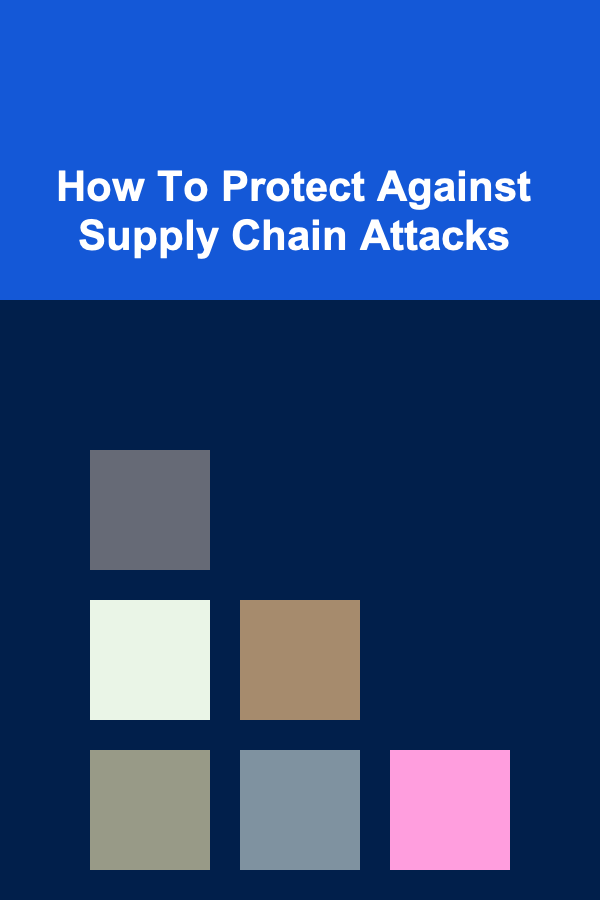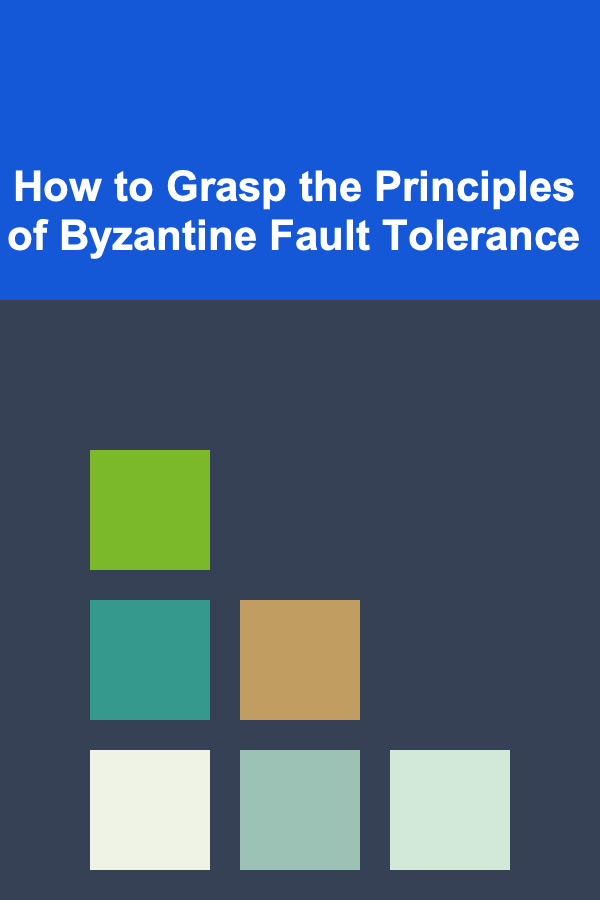
How To Protect Against Supply Chain Attacks
ebook include PDF & Audio bundle (Micro Guide)
$12.99$8.99
Limited Time Offer! Order within the next:

Supply chain attacks are a growing threat in today's interconnected world. These attacks target the weakest link in the supply chain, which often happens to be third-party vendors or suppliers with access to a company's critical systems. The impact of such attacks can be devastating, as seen in numerous high-profile cases like the SolarWinds breach. As businesses increasingly rely on third-party vendors, the risk of supply chain attacks continues to rise, making it crucial for organizations to take proactive measures to protect themselves.
In this article, we will delve into the nature of supply chain attacks, why they are so dangerous, and most importantly, how organizations can protect themselves against them.
What Are Supply Chain Attacks?
A supply chain attack is a cyberattack where an attacker compromises a supplier or vendor to gain access to the target organization's network. The attacker targets a trusted partner or third-party service provider who has access to the organization's infrastructure, data, or software. Because these third parties are often given privileged access to the organization's systems, a breach at this point in the supply chain can lead to massive security issues for the primary target.
There are several types of supply chain attacks, including:
- Software Supply Chain Attacks: The attacker compromises a software vendor to inject malicious code into software updates or patches. Once the update is downloaded by users, the attacker gains access to their systems.
- Hardware Supply Chain Attacks: These involve compromising hardware components that are either manufactured or installed by a third party. These attacks can result in the installation of malicious firmware or backdoors.
- Third-Party Service Provider Attacks: Attackers target the services provided by third-party vendors. This can range from IT support providers to cloud service providers, allowing attackers to access sensitive data or systems of their customers.
- Logistics and Procurement Attacks: Attackers compromise suppliers involved in the logistics or procurement process, such as shipping, warehouse management, and product sourcing, to gain access to physical assets or supply critical infrastructure components with malicious devices or software.
The rise in such attacks highlights the need for businesses to reconsider how they approach cybersecurity and rethink the security of their supply chain as a whole.
Why Are Supply Chain Attacks So Dangerous?
Supply chain attacks are particularly dangerous for several reasons:
- Trusted Relationships: Organizations trust their suppliers and vendors, often granting them significant access to systems and data. This trust makes it easier for attackers to bypass traditional security measures by leveraging a legitimate point of entry.
- Wide Impact: A successful supply chain attack can affect multiple organizations at once. For example, if an attacker compromises a software vendor, the same malicious update can be distributed to every customer that uses that software, potentially affecting a large number of companies simultaneously.
- Difficulty in Detection: Supply chain attacks are often difficult to detect, as they typically exploit existing relationships and trusted systems. The attacker may operate silently within the system for an extended period, allowing them to exfiltrate data or disrupt operations without being noticed.
- Long-Term Consequences: The fallout from a supply chain attack can extend far beyond the immediate breach. Organizations may suffer long-term damage to their reputation, lose customer trust, or face significant financial losses due to the breach.
- Complexity of Mitigation: Unlike direct cyberattacks, which target a single organization's systems, supply chain attacks involve external parties. This complexity can make it challenging for organizations to fully control the security of their supply chains, especially if they work with numerous vendors and third-party services.
The potential for widespread and long-lasting damage makes it imperative for organizations to adopt a comprehensive approach to protecting against supply chain attacks.
How To Protect Against Supply Chain Attacks
Given the risks associated with supply chain attacks, it is essential that organizations take proactive measures to protect themselves. Below are key strategies that can help mitigate the risk of such attacks:
1. Conduct Thorough Vendor Risk Assessments
Before engaging with any third-party vendors, it is critical to conduct comprehensive risk assessments. These assessments should cover a wide range of security concerns, including the vendor's cybersecurity practices, data handling policies, and history of security incidents. Vendors that handle sensitive data or have access to critical systems should be thoroughly vetted.
Consider evaluating:
- Cybersecurity Posture: Assess the vendor's cybersecurity practices, including their encryption methods, patch management procedures, and compliance with industry standards (e.g., ISO 27001, NIST).
- Third-Party Security Audits: Ensure that vendors undergo regular third-party security audits and can provide evidence of their cybersecurity performance.
- Incident Response and Recovery: Understand how vendors respond to security incidents. This includes knowing how quickly they can detect, contain, and recover from a breach.
The goal is to identify potential vulnerabilities in a vendor's infrastructure before entering into a contractual relationship.
2. Use Multi-Factor Authentication (MFA)
Multi-factor authentication (MFA) adds an extra layer of security by requiring users to authenticate through two or more factors---something they know (password), something they have (token or smartphone), or something they are (biometric verification). Implementing MFA across all points of entry into your systems, including those accessed via third-party vendors, can greatly reduce the chances of unauthorized access in the event of a supply chain compromise.
Ensure that vendors and third-party providers who have access to your systems are also required to implement MFA. This will significantly improve the security of all interactions between your organization and its suppliers.
3. Monitor and Restrict Vendor Access
Organizations should enforce strict access controls for third-party vendors. Not all vendors need unrestricted access to all systems; in many cases, access can be limited based on necessity. This concept of least privilege helps ensure that vendors can only access the information and systems that are essential for their work.
Key strategies include:
- Segmentation of Networks: Isolate critical systems and data from less-sensitive parts of your network, limiting the access third parties have to only the areas they require.
- Access Reviews: Regularly review and update access permissions to ensure that only the necessary third-party personnel have access to your systems. Revoke access immediately when a vendor relationship ends.
Additionally, continuous monitoring of all third-party access can help detect unusual or unauthorized behavior early.
4. Regularly Update and Patch Software
Supply chain attacks often involve exploiting vulnerabilities in software. Ensuring that your systems are regularly updated and patched is one of the most effective ways to reduce the risk of such attacks.
This includes:
- Automated Updates: Configure systems to receive automatic security patches and updates as soon as they are available. This ensures that critical vulnerabilities are addressed promptly.
- Vendor Patches: Keep track of patch releases from your vendors and ensure that their software is always up to date. A compromised software vendor could use a security flaw to inject malicious code into updates.
- Vulnerability Scanning: Implement regular vulnerability scans to identify weaknesses in your systems that could be exploited by attackers.
While patch management is often a time-consuming task, it is crucial for mitigating the risk of cyberattacks, especially those targeting software supply chains.
5. Implement a Strong Incident Response Plan
Having a robust incident response plan (IRP) is essential for any organization. In the event of a supply chain attack, an IRP helps organizations quickly detect, contain, and respond to the breach, minimizing the potential damage.
Key components of an IRP include:
- Identification and Notification Procedures: Define clear steps for identifying and notifying internal and external stakeholders about a potential breach.
- Containment and Eradication: Establish processes for containing the attack and removing any malicious code or unauthorized access from the network.
- Recovery and Communication: Outline recovery steps, including restoring systems from backups, and ensure clear communication with customers, vendors, and the public to maintain transparency.
By having a well-rehearsed incident response plan in place, organizations can respond swiftly and effectively to minimize the impact of a supply chain attack.
6. Supply Chain Transparency and Collaboration
Organizations should foster transparency and collaboration with their suppliers and vendors. This includes sharing cybersecurity best practices, working together to address vulnerabilities, and maintaining open communication about security risks.
Supply chain transparency also involves understanding how your suppliers manage their supply chains. For example, if a supplier uses subcontractors, ensure they follow similar security practices. Consider requiring vendors to perform regular security audits and provide evidence of their compliance with cybersecurity standards.
7. Educate Employees and Partners on Cybersecurity
Even the best technical measures can be undermined by human error. Educating employees and partners about cybersecurity best practices is critical in defending against supply chain attacks.
Training should focus on:
- Phishing and Social Engineering Awareness: Employees should be trained to recognize phishing attempts and other forms of social engineering that could be used to exploit vulnerabilities in the supply chain.
- Third-Party Risk Awareness: Raise awareness about the importance of securing the supply chain and the risks associated with third-party vendors.
- Secure Practices for Remote Work: In today's hybrid work environment, ensuring that employees follow secure practices when accessing company systems from home or public networks is vital.
Regular cybersecurity training and awareness programs help to create a security-conscious culture within your organization and among its partners.
Conclusion
Supply chain attacks are a serious and growing threat that requires a comprehensive, proactive approach to mitigate. By thoroughly vetting vendors, implementing strong access controls, keeping software up to date, and fostering collaboration with partners, organizations can reduce the risk of falling victim to these attacks. While supply chain security is complex and requires continuous effort, the long-term benefits of safeguarding your systems, data, and reputation far outweigh the cost of mitigation. By following these strategies, businesses can better protect themselves and their customers from the far-reaching impacts of supply chain attacks.

How to Build a Spring Cleaning Checklist for Your Bathroom
Read More
How to Increase Your Rental Property's Value
Read More
How to Stage a Home with Neutral Decor for Maximum Appeal
Read More
How to Plan a Healthy Diet for Cancer Prevention
Read More
How to Grasp the Principles of Byzantine Fault Tolerance
Read More
How To Find TV Shows Based on Your Favorite Books
Read MoreOther Products

How to Build a Spring Cleaning Checklist for Your Bathroom
Read More
How to Increase Your Rental Property's Value
Read More
How to Stage a Home with Neutral Decor for Maximum Appeal
Read More
How to Plan a Healthy Diet for Cancer Prevention
Read More
How to Grasp the Principles of Byzantine Fault Tolerance
Read More